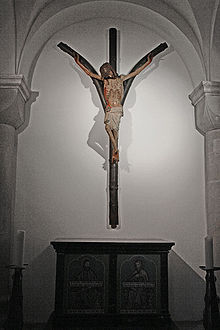Fork cross
A pall , even Crucifixus dolorosus , mystic crucifix , fork crucifix , Schächerkreuz or Pestkreuz , a particularly expressive is Gothic crucifix type Y-shape, according to recent research under the influence of mysticism emerged and in the late 13th or early 14th century, especially in the Rhineland encountered is. In heraldry, the Y-shaped fork cross is also drawbar called the Ψ-shaped are called pile drawbar or gusset.
description
It is believed that the forked cross symbolizes the tree of life . The term thief cross refers to depictions in which Jesus is struck on a Latin or a dew cross , the two thieves crucified with him on his left and right but on Y-shaped crosses.
Typical of a Crucifixus dolorosus ("crucified in pain") is the body of Jesus Christ hanging on a Y-shaped fork of a tree with his head sunk low on his chest, mouth contorted with pain and breaking eyes. The arms are stretched more upwards than to the sides, the emaciated body is strongly curved and sunk below the long sternum, with protruding ribs and a gaping wound on the side. Fingers and toes are spread and convulsively curved. The overall impression of the colored figures was so terrifying that believers were terrified. It is said that the Bishop of London had a mystic crucifix removed for this reason in 1306.
Emergence
Spiritual currents of the 13th and 14th centuries In the 19th century, under the influence of mysticism, a piety of passion developed , which was expressed in this pictorial form, which depicts the crucified Christ suffering in a particularly haunting manner. In the history of art, the technical term Crucifixus dolorosus prevailed, which was introduced by the Italian art historian Geza de Francovich. Gothic crucifixes of the Passion are often forked crosses, some also in Latin . Almost always it is a question of branch crosses that remind of the tree of life with vegetable shapes. The previously used term “plague cross” is misleading, as the Crucifixi dolorosi were created around and shortly after 1300, i.e. before the outbreak of the great plague epidemics in Western Europe. Little is known about the original function. It is certain that the Coesfeld Cross was led through the city during processions from the very beginning. Many fork crosses are found among Dominicans and Franciscans , especially in Italy. During the time of the Counter Reformation , people began to venerate the cross with a cross costume in some places .
Occurrence
The forked cross of St. Maria in the Capitol in Cologne was long considered the oldest forked crucifix. Restoration work showed, however, that it was not the original shape of all forked crosses, but that this crucifix may only have stimulated the spread of this cross shape in the Rhineland. The cross was created before 1312. The restoration work in recent years has largely uncovered the late medieval second version. Small sections of the uncovered first version show astonishing similarities with the original color version of the Bocholt Cross, which has been visible again since 1967, which was based on the Cologne Cross, although different barrel painters were at work.
The style of the Crucifixus dolorosus from St. Maria in the Capitol can hardly be connected with the Rhenish and Cologne sculptures of its time; so far it seemed to be a singular work of outstanding quality. It therefore seems questionable that this forked cross was created by a Cologne carver. The other sculptures of this genre in Germany also appear as extraordinary in their respective regional art. In contrast, artistic connections to crosses in other countries can be recognized; the influence of Italy seems particularly clear. It is therefore possible that the original forked crucifixes are imported pieces or that they were created by traveling artists, which in the case of the crucifix in St. Maria im Kapitol is also supported by the use of the local walnut wood.
An early example of these crucifixes can be found next to St. Maria in the Capitol in the St. Severin Church in Cologne. Other crosses that emerged later are the Bocholter and Coesfeld crosses in the Münsterland as well as two forked crosses in Borken ( Borkener forked cross ) and Haltern am See . The crucifixes in St. Simon and Juda in Thorr (Bergheim district), St. Johannes in Lage (Rieste, Lower Saxony), the cross in St. Peter (Merzig) and the crucifix in the Catholic parish church of St. Johannes Baptist in Kendenich (town Hürth ) also belong to this group.
See also
literature
- Monika von Alemann-Schwartz: Crucifixus dolorosus. Contributions to the polychromy and iconography of the Rhenish fork crucifixes. Bonn 1976, (Bonn, University, dissertation. 1976).
- Géza de Francovich: L'origine e la diffusione dell crocifisso gotico doloroso. In: The Art History Yearbook of the Bibliotheca Hertziana. Vol. 2, 1938, ISSN 0258-557X , pp. 143-265.
- Godehard Hoffmann: The fork cross in St. Maria in the Capitol of Cologne and the phenomenon of the Crucifixi dolorosi in Europe = workbook of the Rhenish preservation of monuments 69 = studies on art monuments in the Archbishopric of Cologne 2. Werner publishing company , Worms 2006. ISBN 3-88462-240-4
- Felix Liebermann : A German sculptor in London 1306. In: Repertory for art history. Vol. 33, 1910, ISSN 0259-7063 , p. 550.
- Fried Mühlberg : Crucifixus Dolorosus. About the meaning and origin of the Gothic forked crucifix. In: Wallraf-Richartz-Jahrbuch. Vol. 22, 1960, ISSN 0083-7105 , pp. 69-86.
- Max Strucken: Literary and artistic sources of the fork crucifix. Strucken, Düsseldorf 1928, (Cologne, university, dissertation, 1928).
Web links
Individual evidence
- ^ Benedikt Benninghaus: The continuity of the pilgrimage to the Holy Cross in location (= research on folklore. H. 60). Verlags-Haus Monsenstein and Vannerdat, Münster 2014, ISBN 978-3-95645-254-3 .


